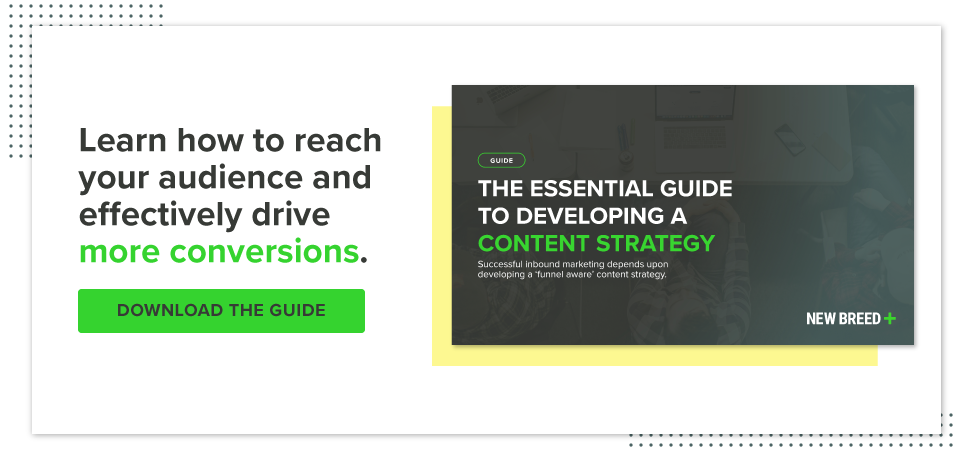
A case study is a success story about the work you’ve done or the impact your product has had on a customer.
They’re typically content leveraged during the decision stage of the buyer’s journey to support why a prospect should choose your company over competitors.
“Case studies help build trust with your prospects,” New Breed’s Head of Demand Generation Guido Bartolacci says. “They help people understand that you’re actually capable of doing or delivering what you say you’re going to do or deliver.”
Without a concrete example, it can be hard for prospects to visualize the impact your solution will have on them or believe that your solution will work the way you say it will.
“A case study shows someone a clear, grounded example of the work you’ve described during the sales process,” Guido says.
Here are five questions every case study should answer.
1. Who is the Company That Benefited from Your Solution?
“In order to convey the story of how your offering helped another company, people first need to understand who that company is and what they do,” Guido says.
Ideally, you’ll have case studies that encompass all the verticals you work with. That will enable prospects to find an example of your solution working for a company that they can relate to.
This portion of the case study is relatively short and typically informed by how the company talks about themself. It generally includes a brief description of what the company does, how big they are and where they’re located.
2. What Was Life Like for the Company Prior to Your Solution?
In order to effectively demonstrate how your business’s offering helped your customer, you need to provide context about what life was previously like for them. What led to them turning to you for help?
“What were the major pain points and challenges that they faced? How were they impacting their business negatively? To what extent did they realize what was going on at the time?” Guido says. “Sometimes during the sales process, we help companies understand that there’s more at play than just this one issue. I think all of that should be brought up in this section of the case study.”
3. What Did Your Company Do to Help?
Depending on what your product or service does, this section can be very expansive or very concise.
This section should discuss how the customer got started with your product or service, who was involved on both sides, how it was being used and how it was adopted.
There’s is no universal requirement for what information to include in this part of the case study because the specifics will be unique to every company’s offering. If you sell a product, you’ll want to highlight how the customer leveraged your product. If you offer a service, you might describe what the service delivery process looked like.
If possible, you should go into detail about the experience of working together, and if your solution has multiple features or service offerings, you need to define which parts they leveraged.
4. What Were the Results?
The results section of your case study continues the story with quantitative data proving your solution’s benefits.
“Business impact is extremely important at this stage,” Guido says. “The real metric you want to get at is ROI. ROI is normally going to be a function of time savings or revenue generation and how each of those things relates to the investment they made.”
If you’re not able able to show ROI because you don’t have access to that data or your customer doesn’t want to disclose information that reveals too much about their operating costs, you can focus on highlighting metrics that reflect your solution’s value proposition instead.
Even if you can include ROI, you should still provide other metrics that demonstrate your solution’s results leading up to that.
For example, ROI for a marketing agency like New Breed would be our client’s net profit divided by the cost of our engagement. While showing that they gained more than they invested is the ultimate goal, we would also want to include supporting metrics like how many more customers they were able to close, how much lead generation increased, how their site performance improved or how their search rankings rose.
5. How Did It Impact the Company?
There are some benefits of your solution that you won’t be able to quantify. If your solution reduces stress, increases morale, boosts collaboration, etc., it can be hard to collect data that proves how your solution affected those areas. To account for that, an impact section should include a testimonial from your customer about how your solution made their life better.
“The whole idea of your brand is to build a connection with people using it. Impact is a way to actually illustrate that,” Guido says.
When your prospect hears directly from a peer how your product made their life easier, it instills trust that your company can actually help them. Ending with a quote that sums up your customer’s success with your offering also concludes the case study nicely.
Quinn Kanner
Quinn is a writer and copyeditor whose work ranges from journalism to travel writing to inbound marketing content.





